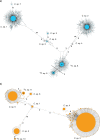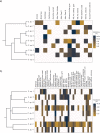Resolving cryptic species complexes in marine protists: phylogenetic haplotype networks meet global DNA metabarcoding datasets
- PMID: 33589768
- PMCID: PMC8245484
- DOI: 10.1038/s41396-021-00895-0
Resolving cryptic species complexes in marine protists: phylogenetic haplotype networks meet global DNA metabarcoding datasets
Abstract
Marine protists have traditionally been assumed to be lowly diverse and cosmopolitan. Yet, several recent studies have shown that many protist species actually consist of cryptic complexes of species whose members are often restricted to particular biogeographic regions. Nonetheless, detection of cryptic species is usually hampered by sampling coverage and application of methods (e.g. phylogenetic trees) that are not well suited to identify relatively recent divergence and ongoing gene flow. In this paper, we show how these issues can be overcome by inferring phylogenetic haplotype networks from global metabarcoding datasets. We use the Chaetoceros curvisetus (Bacillariophyta) species complex as study case. Using two complementary metabarcoding datasets (Ocean Sampling Day and Tara Oceans), we equally resolve the cryptic complex in terms of number of inferred species. We detect new hypothetical species in both datasets. Gene flow between most of species is absent, but no barcoding gap exists. Some species have restricted distribution patterns whereas others are widely distributed. Closely related taxa occupy contrasting biogeographic regions, suggesting that geographic and ecological differentiation drive speciation. In conclusion, we show the potential of the analysis of metabarcoding data with evolutionary approaches for systematic and phylogeographic studies of marine protists.
Conflict of interest statement
The authors declare that they have no conflict of interest.
Figures




References
-
- Mayr E. Populations, species, and evolution: an abridgment of animal species and evolution. Cambridge: Belknap Press of Harvard University Press; 1970.
-
- Bickford D, Lohman DJ, Sodhi NS, Ng PKL, Meier R, Winker K, et al. Cryptic species as a window on diversity and conservation. Trends Ecol Evol. 2007;22:148–55. - PubMed
-
- Fišer C, Robinson CT, Malard F. Cryptic species as a window into the paradigm shift of the species concept. Mol Ecol. 2018;27:613–35. - PubMed
-
- Struck TH, Feder JL, Bendiksby M, Birkeland S, Cerca J, Gusarov VI, et al. Finding evolutionary processes hidden in cryptic species. Trends Ecol Evol. 2018;33:153–63. - PubMed
-
- Sarno D, Kooistra WHCF, Medlin LK, Percopo I, Zingone A. Diversity in the genus Skeletonema (Bacillariophyceae). II. An assessment of the taxonomy of S. costatum-like species with the description of four new species. J Phycol. 2005;41:151–76.
Publication types
MeSH terms
Associated data
LinkOut - more resources
Full Text Sources
Other Literature Sources
Miscellaneous

